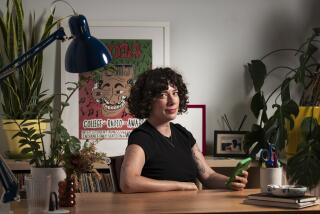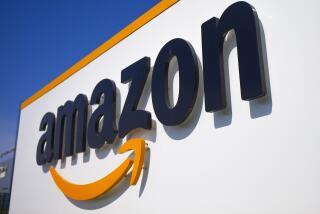Digitizing life’s clutter
- Share via
OAKLAND — As the goods in our daily lives transform from analog to digital, it’s hard not to wonder: Where did all our stuff go?
We take photos, but the leather albums remain empty. The music collection bulges but requires no space next to the stereo. When “War and Peace” lives on electronic reading devices, it can no longer serve as a doorstop or a sign of being well-read.
This dramatic change has upended the media business, offering new ways to find audiences yet undercutting decades-old methods of making money. Even as it has empowered the likes of Google and Apple, the digital transition has hobbled record labels, pushed newspaper publishers to the brink of financial ruin and threatened film and television companies.
But the shift also has happened at a more personal level. In the home, we are torn between the ingrained urge to collect and the newer desire to feel light and mobile, said Aimee Baldridge, author of “Organize Your Digital Life,” a recent how-to book from National Geographic.
The average U.S. consumer owns 792 digital songs, 672 digital photos and 666 digital videos, according to a 2008 study by the Consumer Electronics Assn. In the next five years, this is expected to at least triple.
“People are overwhelmed, and their lives are cluttered with things and information,” Baldridge said. They “are looking for ways to simplify. Digital technology seems like a way to sweep things clean. But often it complicates things.”
The drama has played out in my family, changing the ecology of our home and our experience of culture. The towers of CDs have been razed. Bookshelves are trimmer -- new purchases go into our Amazon Kindle e-book reader. There is no movie collection piled up beside our television. Why should there be? We have iTunes to download films.
When we do get DVDs, they’re whisked back to Netflix as soon as we watch them, or we gather around the computer screen to take in films via the company’s “Watch Instantly” streaming video service.
Photos, music, books and videos disappear into the black hole of our computer’s hard drive, where we forget about most of them. Many of the framed photos around our house are from before 2000, when the digital camera became king. The online newspaper doesn’t call out to be read like its printed sibling did lying on the breakfast table.
“It used to be, as Marshall McLuhan said, that the medium was the message,” said Paul Saffo, a Silicon Valley forecaster and consulting associate professor at Stanford University. “Now the medium is invisible.”
Our home’s purge of physical media was driven by my husband, Michael. He’s a university librarian, trained to look at shelf space as critically as a Wal-Mart bean counter: If the inventory isn’t moving, stash it away.
His motto, “Everything has a place, everything in its place,” has become a survival strategy for our family of four to coexist in a 1,200-square-foot house with no garage. It drives him to digitize and organize.
I can’t help but push back. Though I have reported about technology for two decades, I find myself trying to horde things I can hold in my hands.
Of course, there are technology solutions for revitalizing digital content. Digital photo frames can be replenished wirelessly. Devices such as the Roku box and Apple TV make it possible to stream videos from the computer to the living-room set. Grandma in Atlanta can visit a video-sharing website to catch her grandchild’s first step in Seattle.
We can scroll through playlists on our iPods or computers to find forgotten classics. I once couldn’t find a marimba CD. When I discovered its digital replica on our computer, where Michael had stashed it as part of his great physical album purge of 2006, I found a half-dozen like it I had forgotten.
And software engineers at Amazon.com, Apple, Netflix and elsewhere have created “recommendation engines” to suggest new books, music and videos based on feedback about those we’ve already bought or rented.
Still, Baldridge doesn’t recommend a wholesale switch to digital. “It’s evolved so rapidly, it’s hard to get a handle on what the benefits are, what the uses are and what’s overkill,” she said. “What I advise people to do is find a good balance between digital and physical stuff.”
For many, the digital train has left, and we are on for the ride. It’s changing us. A vast, impersonal library of media is replacing a small, idiosyncratic collection of books, music, photos and video that made their presence known.
“We have physical and tactile relationships with things we don’t think we have a relationship to,” said Paul Duguid, a professor in the School of Information at UC Berkeley. “It will make the world a confusing place if we have to remember things by menus.”
Without cultural artifacts lying around, we lose the status we used to derive from them. It’s hard to surreptitiously take stock of someone’s musical tastes if you have to sneak a peek at their iPod or ask for their computer password.
It’s the same with books -- Jay Gatsby knew he got something from the physical presence of books, even if the ones on his shelf had never been opened, their pages still uncut.
Today, the showoffs have moved online, using programs like WeRead on Facebook to brag about what they’ve read.
Recently, my 6-year-old son kicked a soccer ball indoors and hit a small pile of CDs on a high shelf, waiting to be digitized. The jewel cases smashed. My son picked up a CD from the floor, put it in his portable player and became a fan of the rock band the White Stripes.
He now plays air guitar along with the music. Call it a victory for old-school discovery.
The same sort of collision will happen less and less in our world of digital substitution. There probably won’t be a rainy day a decade from now when, as a bored teenager, he’ll feel called to “Nixonland: The Rise of a President and the Fracturing of America” after seeing it on the bookshelf for years. He won’t pull it down, dust it off and begin to read.
No, the book exists on the digital shelf inside my Kindle.
Maybe someday the successors to those recommendation programs will scan our entire digital media libraries, make thematic connections and suggest titles he’d enjoy: If he liked this song, which mentions the 37th president, he might want to read “Nixonland.”
“Every generation is more sophisticated than the generation that preceded it in the use of digital media,” said John C. B. LeGates, managing director and co-founder of Harvard University’s Program on Information Resources Policy. “The freshman is more sophisticated than the sophomore, and you can measure it right up to the faculty. The usage of non-digital media is dying out.”
I’m trying to keep it alive. So, I’ve become a sheepish advocate for letting culture clutter our home. I deliberately clog shelves and corners with books, magazines, newspapers and CDs. I vow to fill the few empty photo albums gathering dust before they get cleared out.
Saying goodbye to surfaces is part of taking a small stand against the 21st century sweep of everything, out and up into a cloud of content.
--
--
BEGIN TEXT OF INFOBOX
Taking the digital plunge
Digitizing music, books and photos may seem like a no-brainer, but it doesn’t make sense for everyone. Here are a few things to consider when deciding whether to make the switch.
PROS OF GOING DIGITAL
* Takes up little room
* Shows off tech savvy
* Can be copied to guard against loss
* Portable
* Easily searchable
* Immune to decay
CONS OF GOING DIGITAL
* No decorative value
* Hard to show off cultural sophistication
* Requires a learning curve to use
* Limited accessibility to little kids and technophobes
* No resale value
* Vulnerable to obsolescence as formats change
Source: Times research
More to Read
Sign up for our Book Club newsletter
Get the latest news, events and more from the Los Angeles Times Book Club, and help us get L.A. reading and talking.
You may occasionally receive promotional content from the Los Angeles Times.










